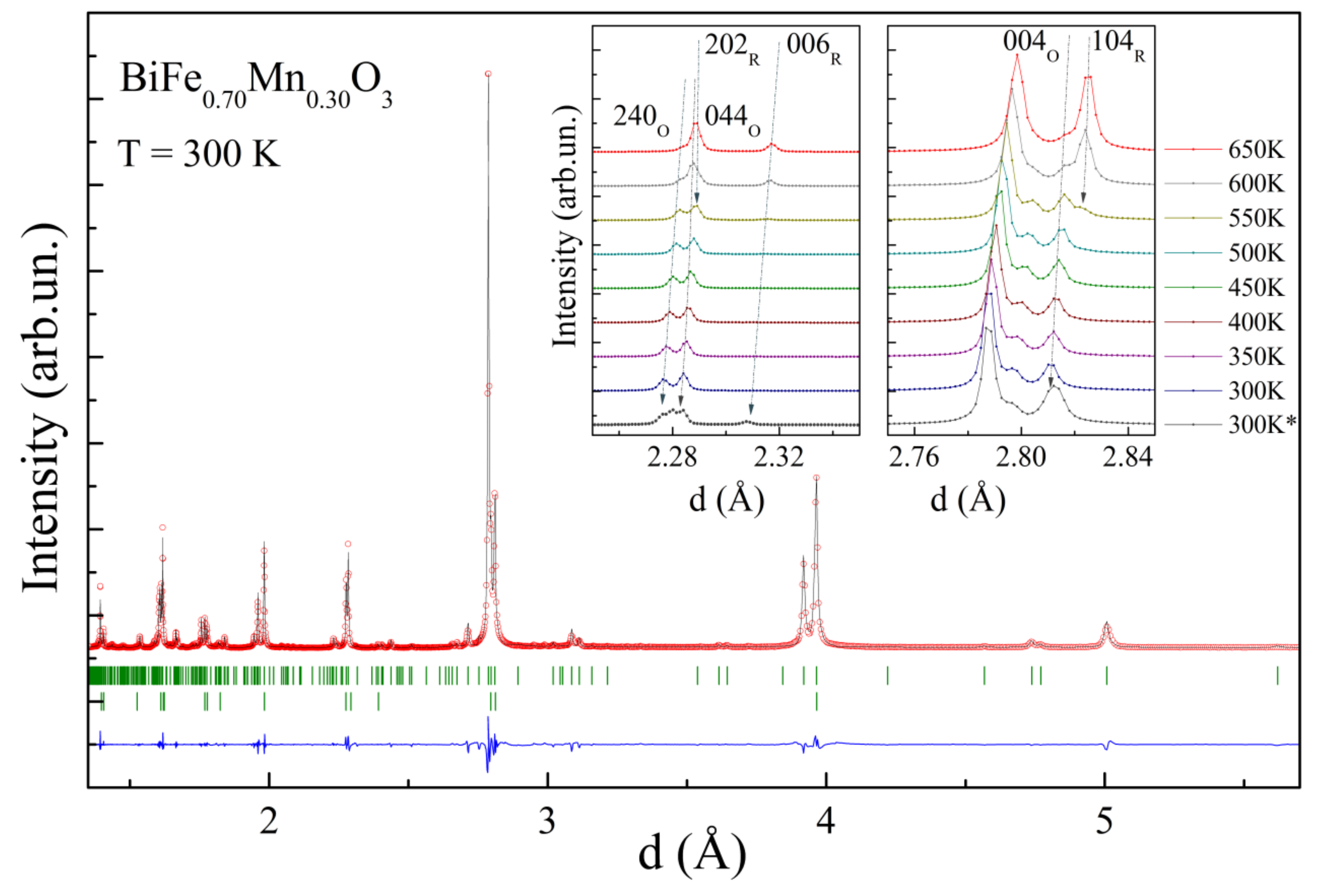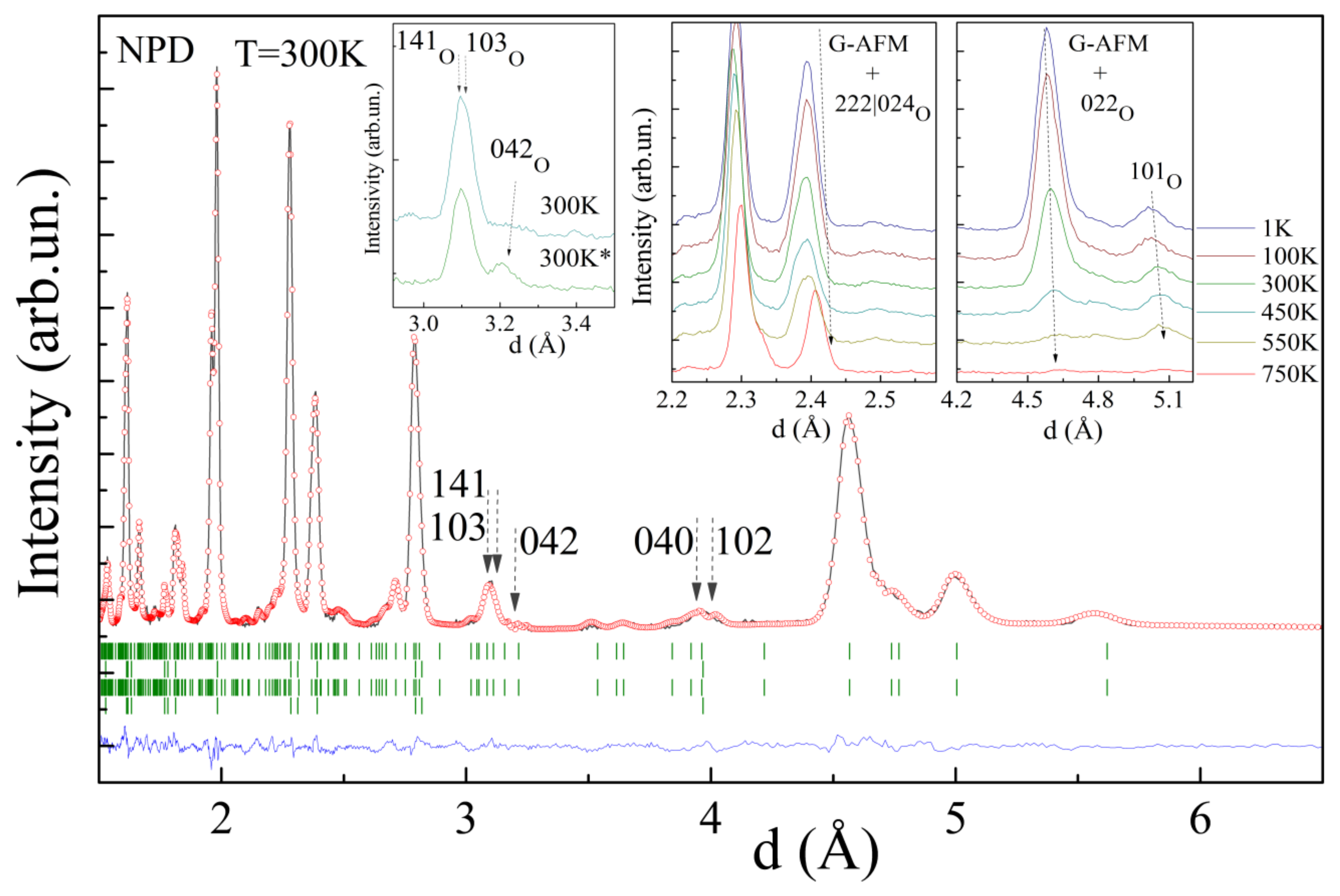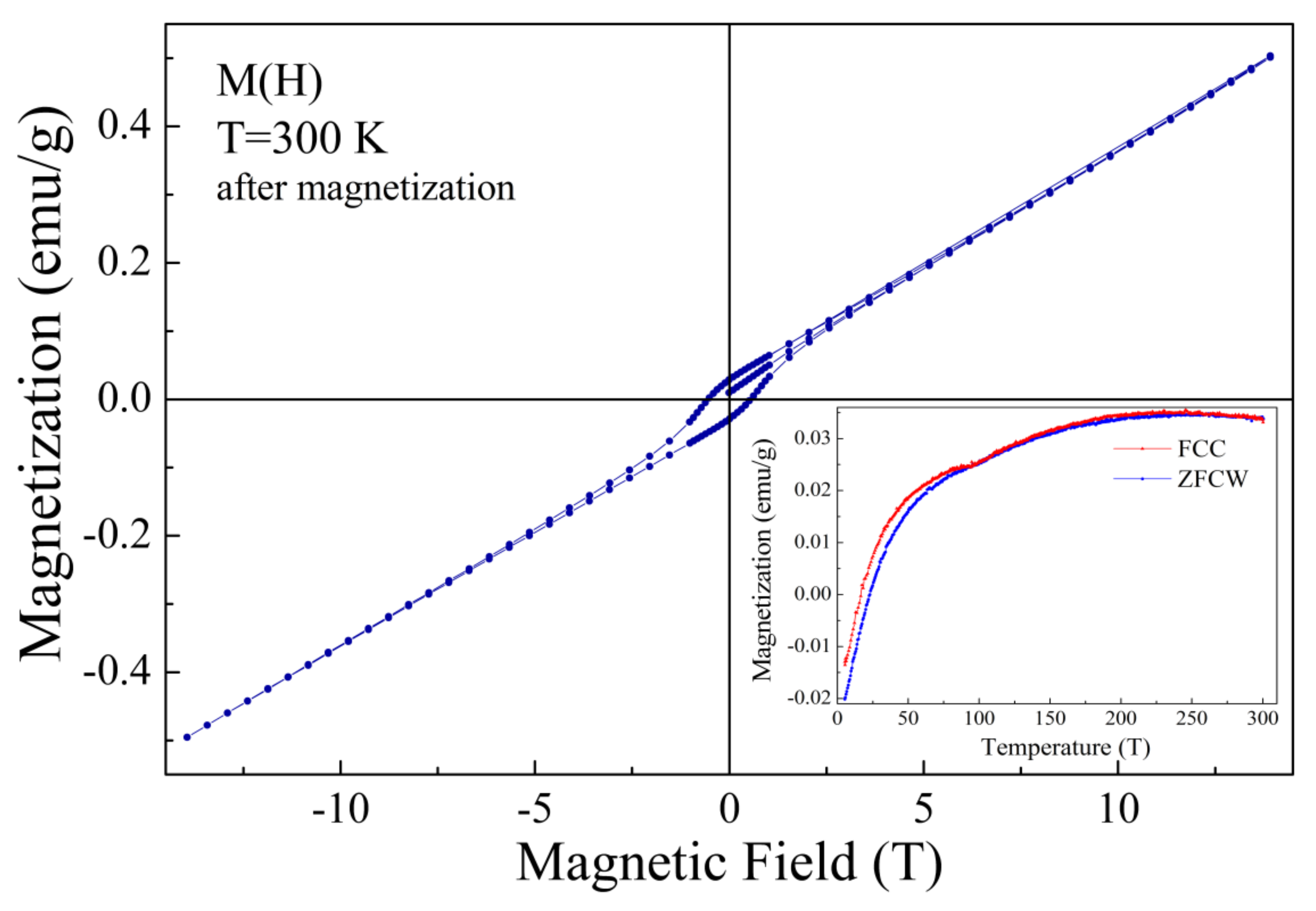Temperature-Driven Transformation of the Crystal and Magnetic Structures of BiFe0.7Mn0.3O3 Ceramics
Abstract
:1. Introduction
2. Experimental
3. Results
4. Conclusions
Author Contributions
Funding
Institutional Review Board Statement
Informed Consent Statement
Data Availability Statement
Acknowledgments
Conflicts of Interest
References
- Spaldin, N.A.; Ramesh, R. Advances in magnetoelectric multiferroics. Nat. Mater. 2019, 18, 203–212. [Google Scholar] [CrossRef] [PubMed]
- Kitagawa, Y.; Hiraoka, Y.; Honda, T.; Ishikura, T.; Nakamura, H.; Kimura, T. Low-field magnetoelectric effect at room temperature. Nat. Mater. 2010, 9, 797–802. [Google Scholar] [CrossRef] [PubMed]
- Rao, C.N.; Sundaresan, A.; Saha, R. Multiferroic and Magnetoelectric Oxides: The Emerging Scenario. J. Phys. Chem. Lett. 2012, 3, 2237–2246. [Google Scholar] [CrossRef] [PubMed]
- Khomchenko, V.A.; Troyanchuk, I.O.; Karpinsky, D.V.; Das, S.; Amaral, V.S.; Tovar, M.; Sikolenko, V.; Paixão, J.A. Structural transitions and unusual magnetic behavior in Mn-doped Bi1−xLaxFeO3 perovskites. J. Appl. Phys. 2012, 112, 084102. [Google Scholar] [CrossRef]
- Troyanchuk, I.O.; Bushinsky, M.V.; Karpinsky, D.V.; Sirenko, V.; Sikolenko, V.; Efimov, V. Structural and magnetic phases of Bi1−xAxFeO3−δ (A = Sr, Pb) perovskites. Eur. Phys. J. B 2010, 73, 375–381. [Google Scholar] [CrossRef]
- Palaimiene, E.; Macutkevic, J.; Karpinsky, D.V.; Kholkin, A.L.; Banys, J. Dielectric investigations of polycrystalline samarium bismuth ferrite ceramic. Appl. Phys. Lett. 2015, 106, 012906. [Google Scholar] [CrossRef]
- Min, K.; Huang, F.; Jin, Y.; Zhu, W.; Zhu, J. Oxygen-vacancy-related dielectric relaxation in BiFeO3 ceramics. Ferroelectrics 2013, 450, 42–48. [Google Scholar] [CrossRef]
- Yue, R.; Ramaraj, S.G.; Liu, H.; Elamaran, D.; Elamaran, V.; Gupta, V.; Arya, S.; Verma, S.; Satapathi, S.; Hayawaka, Y.; et al. A review of flexible lead-free piezoelectric energy harvester. J. Alloys Compd. 2022, 918, 165653. [Google Scholar] [CrossRef]
- Wu, J.; Fan, Z.; Xiao, D.; Zhu, J.; Wang, J. Multiferroic bismuth ferrite-based materials for multifunctional applications: Ceramic bulks, thin films and nanostructures. Prog. Mater Sci. 2016, 84, 335–402. [Google Scholar] [CrossRef]
- Yang, S.Y.; Zavaliche, F.; Mohaddes-Ardabili, L.; Vaithyanathan, V.; Schlom, D.G.; Lee, Y.J.; Chu, Y.H.; Cruz, M.P.; Zhan, Q.; Zhao, T.; et al. Metalorganic chemical vapor deposition of lead-free ferroelectric BiFeO3 films for memory applications. Appl. Phys. Lett. 2005, 87, 102903. [Google Scholar] [CrossRef]
- Catalan, G.; Scott, J.F. Physics and Applications of Bismuth Ferrite. Adv. Mater. 2009, 21, 2463. [Google Scholar] [CrossRef]
- Morozovska, A.N.; Eliseev, E.A.; Glinchuk, M.D.; Fesenko, O.M.; Shvartsman, V.V.; Gopalan, V.; Silibin, M.V.; Karpinsky, D.V. Rotomagnetic coupling in fine-grained multiferroic BiFeO3: Theory and experiment. Phys. Rev. B 2018, 97, 134115. [Google Scholar] [CrossRef]
- Kan, D.; Palova, L.; Anbusathaiah, V.; Cheng, C.J.; Fujino, C.J.; Nagarajan, V.; Rabe, K.M.; Takeuchi, I. Universal behavior and electric-field-induced structural transition in rare-earth-substituted BiFeO3. Adv. Funct. Mater. 2010, 20, 1108–1115. [Google Scholar] [CrossRef]
- Du, Y.; Cheng, Z.X.; Shahbazi, M.; Collings, E.W.; Dou, S.X.; Wang, X.L. Enhancement of ferromagnetic and dielectric properties in lanthanum doped BiFeO3 by hydrothermal synthesis. J. Alloys Compd. 2010, 490, 637–641. [Google Scholar] [CrossRef]
- Yang, C.-H.; Kan, D.; Takeuchi, I.; Nagarajan, V.; Seidel, J. Doping BiFeO3: Approaches and enhanced functionality. Phys. Chem. Chem. Phys. 2012, 14, 15953–15962. [Google Scholar] [CrossRef]
- Khomchenko, V.A.; Karpinsky, D.V.; Pereira, L.C.J.; Kholkin, A.L.; Paixão, J.A. Mn substitution-modified polar phase in the Bi1-xNdxFeO3 multiferroics. J. Appl. Phys. 2013, 113, 214112. [Google Scholar] [CrossRef]
- Khomchenko, V.A.; Das, M.; Paixão, J.A.; Silibin, M.V.; Karpinsky, D.V. Structural and magnetic phase transitions in Ca-substituted bismuth ferromanganites. J. Alloys Compd. 2022, 901, 163682. [Google Scholar] [CrossRef]
- Karpinsky, D.V.; Silibin, M.V.; Trukhanov, A.V.; Zhaludkevich, A.L.; Maniecki, T.; Maniukiewicz, W.; Sikolenko, V.; Paixão, J.A.; Khomchenko, V.A. A correlation between crystal structure and magnetic properties in co-doped BiFeO3 ceramics. J. Phys. Chem. Solids 2019, 126, 164–169. [Google Scholar] [CrossRef]
- Wang, D.; Fan, Z.; Li, W.; Zhou, D.; Feteira, A.; Wang, G.; Murakami, S.; Sun, S.; Zhao, Q.; Tan, X.; et al. High Energy Storage Density and Large Strain in Bi(Zn2/3Nb1/3)O3-Doped BiFeO3-BaTiO3 Ceramics. ACS Appl. Energy Mater. 2018, 1, 4403–4412. [Google Scholar] [CrossRef]
- Belik, A.A. Origin of magnetization reversal and exchange bias phenomena in solid solutions of BiFeO3-BiMnO3: Intrinsic or extrinsic? Inorg. Chem. 2013, 52, 2015–2021. [Google Scholar] [CrossRef]
- Pakalniškis, A.; Lukowiak, A.; Niaura, G.; Głuchowski, P.; Karpinsky, D.V.; Alikin, D.O.; Abramov, A.S.; Zhaludkevich, A.; Silibin, M.; Kholkin, A.L.; et al. Nanoscale ferroelectricity in pseudo-cubic sol-gel derived barium titanate-bismuth ferrite (BaTiO3–BiFeO3) solid solutions. J. Alloys Compd. 2020, 830, 154632. [Google Scholar] [CrossRef]
- Azuma, M.; Kanda, H.; Belik, A.A.; Shimakawa, Y.; Takano, M. Magnetic and structural properties of BiFe1-xMnxO3. J. Magn. Magn. Mater. 2007, 310, 1177–1179. [Google Scholar] [CrossRef]
- Belik, A.A.; Yusa, H.; Hirao, N.; Ohishi, Y.; Takayama-Muromachi, E. Peculiar high-pressure behavior of BiMnO3. Inorg. Chem. 2009, 48, 1000–1004. [Google Scholar] [CrossRef]
- Belik, A.A. Solid Solutions between BiMnO3 and BiCrO3. Inorg. Chem. 2016, 55, 12348–12356. [Google Scholar] [CrossRef] [PubMed]
- Karpinsky, D.V.; Silibin, M.V.; Latushka, S.I.; Zhaludkevich, D.V.; Sikolenko, V.V.; Al-Ghamdi, H.; Almuqrin, A.H.; Sayyed, M.I.; Belik, A.A. Structural and Magnetic Phase Transitions in BiFe1−xMnxO3 Solid Solution Driven by Temperature. Nanomaterials 2022, 12, 1565. [Google Scholar] [CrossRef] [PubMed]
- Selbach, S.M.; Tybell, T.; Einarsrud, M.A.; Grande, T. High-temperature semiconducting cubic phase of BiFe0.7Mn0.3O3+δ. Phys. Rev. B Condens. Matter 2009, 79, 214113. [Google Scholar] [CrossRef]
- Selbach, S.M.; Tybell, T.; Einarsrud, M.A.; Grande, T. Structure and properties of multiferroic oxygen hyperstoichiometric BiFe1-xMnxO3+δ. Chem. Mater. 2009, 21, 5176–5186. [Google Scholar] [CrossRef]
- Belik, A.A.; Abakumov, A.M.; Tsirlin, A.A.; Hadermann, J.; Kim, J.; Van Tendeloo, G.; Takayama-Muromachi, E. Structure and Magnetic Properties of BiFe0.75Mn0.25O3 Perovskite Prepared at Ambient and High Pressure. Chem. Mater. 2011, 23, 4505–4514. [Google Scholar] [CrossRef]
- Gibbs, A.S.; Arnold, D.C.; Knight, K.S.; Lightfoot, P. High-temperature phases of multiferroic BiFe0.7Mn0.3O3. Phys. Rev. B 2013, 87, 224109. [Google Scholar] [CrossRef]
- Daniel, M. Többens, S.Z. KMC-2: An X-ray beamline with dedicated diffraction and XAS endstations at BESSY II. JLSRF 2016, 2, A49. [Google Scholar]
- Svetogorov, R.D.; Dorovatovskii, P.V.; Lazarenko, V.A. Belok/XSA Diffraction Beamline for Studying Crystalline Samples at Kurchatov Synchrotron Radiation Source. Cryst. Res. Technol. 2020, 55, 1900184. [Google Scholar] [CrossRef]
- Fischer, P.; Frey, G.; Koch, M.; Konnecke, M.; Pomjakushin, V.; Schefer, J.; Thut, R.; Schlumpf, N.; Burge, R.; Greuter, U.; et al. High-resolution powder diffractometer HRPT for thermal neutrons at SINQ. Physica B 2000, 276, 146–147. [Google Scholar] [CrossRef]
- Rodríguez-Carvajal, J. Recent advances in magnetic structure determination by neutron powder diffraction. Physica B 1993, 192, 55–69. [Google Scholar] [CrossRef]
- Dzyaloshinsky, I. A thermodynamic theory of “weak” ferromagnetism of antiferromagnetics. J. Phys. Chem. Solids 1958, 4, 241–255. [Google Scholar] [CrossRef]
- Karpinsky, D.V.; Troyanchuk, I.O.; Tovar, M.; Sikolenko, V.; Efimov, V.; Efimova, E.; Shur, V.Y.; Kholkin, A.L. Temperature and Composition-Induced Structural Transitions in Bi1−xLa(Pr)xFeO3 Ceramics. J. Am. Ceram. Soc. 2014, 97, 2631–2638. [Google Scholar] [CrossRef]
- Karpinsky, D.V.; Troyanchuk, I.O.; Mantytskaja, O.S.; Chobot, O.S.; Sikolenko, V.V.; Efimov, V.; Tovar, M. Magnetic and piezoelectric properties of the Bi1−xLaxFeO3 system near the transition from the polar to antipolar phase. Phys. Solid State 2014, 56, 701–706. [Google Scholar] [CrossRef]
- Kumar, A.; Yusuf, S.M. Correlation of exchange-bias effect with negative magnetization in perovskite compound, La0.5Pr0.5CrO3. J. Appl. Phys. 2020, 127, 213903. [Google Scholar]
- Tho, P.T.; Kim, D.H.; Phan, T.L.; Dang, N.V.; Lee, B.W. Intrinsic exchange bias and vertical hysteresis shift in Bi0.84La0.16Fe0.96Ti0.04O3. J. Magn. Magn. Mater. 2018, 462, 172–177. [Google Scholar] [CrossRef]
- Yoshii, K. Positive exchange bias from magnetization reversal in La1-xPrxCrO3 (x ∼0.7–0.85). Appl. Phys. Lett. 2011, 99, 142501. [Google Scholar] [CrossRef]
- Manna, P.K.; Yusuf, S.M. Two interface effects: Exchange bias and magnetic proximity. Phys. Rep. 2014, 535, 61–99. [Google Scholar] [CrossRef]






Publisher’s Note: MDPI stays neutral with regard to jurisdictional claims in published maps and institutional affiliations. |
© 2022 by the authors. Licensee MDPI, Basel, Switzerland. This article is an open access article distributed under the terms and conditions of the Creative Commons Attribution (CC BY) license (https://creativecommons.org/licenses/by/4.0/).
Share and Cite
Karpinsky, D.V.; Silibin, M.V.; Latushka, S.I.; Zhaludkevich, D.V.; Sikolenko, V.V.; Svetogorov, R.; Sayyed, M.I.; Almousa, N.; Trukhanov, A.; Trukhanov, S.; et al. Temperature-Driven Transformation of the Crystal and Magnetic Structures of BiFe0.7Mn0.3O3 Ceramics. Nanomaterials 2022, 12, 2813. https://doi.org/10.3390/nano12162813
Karpinsky DV, Silibin MV, Latushka SI, Zhaludkevich DV, Sikolenko VV, Svetogorov R, Sayyed MI, Almousa N, Trukhanov A, Trukhanov S, et al. Temperature-Driven Transformation of the Crystal and Magnetic Structures of BiFe0.7Mn0.3O3 Ceramics. Nanomaterials. 2022; 12(16):2813. https://doi.org/10.3390/nano12162813
Chicago/Turabian StyleKarpinsky, Dmitry V., Maxim V. Silibin, Siarhei I. Latushka, Dmitry V. Zhaludkevich, Vadim V. Sikolenko, Roman Svetogorov, M. I. Sayyed, Nouf Almousa, Alex Trukhanov, Sergei Trukhanov, and et al. 2022. "Temperature-Driven Transformation of the Crystal and Magnetic Structures of BiFe0.7Mn0.3O3 Ceramics" Nanomaterials 12, no. 16: 2813. https://doi.org/10.3390/nano12162813
APA StyleKarpinsky, D. V., Silibin, M. V., Latushka, S. I., Zhaludkevich, D. V., Sikolenko, V. V., Svetogorov, R., Sayyed, M. I., Almousa, N., Trukhanov, A., Trukhanov, S., & Belik, A. А. (2022). Temperature-Driven Transformation of the Crystal and Magnetic Structures of BiFe0.7Mn0.3O3 Ceramics. Nanomaterials, 12(16), 2813. https://doi.org/10.3390/nano12162813











